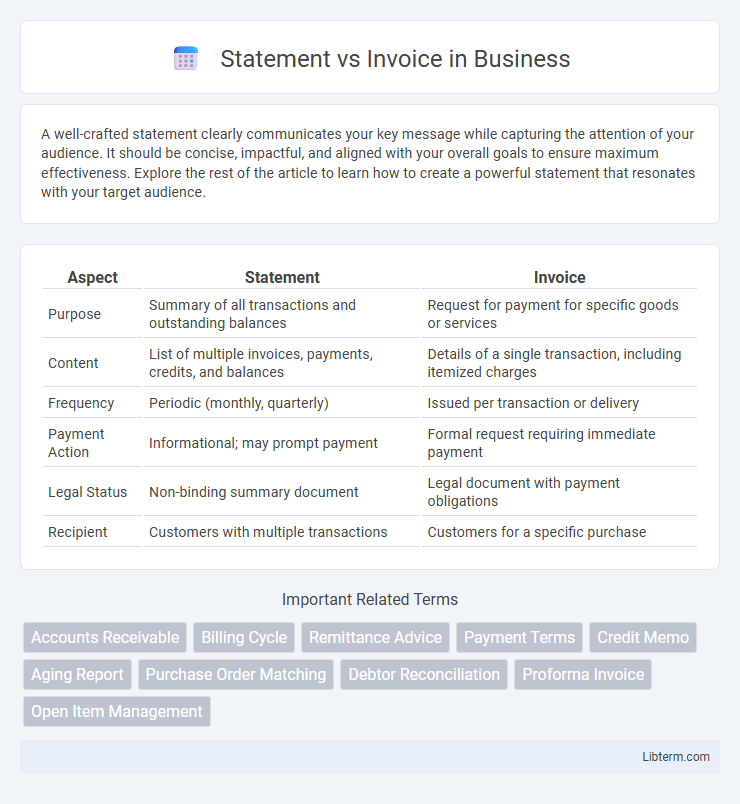A well-crafted statement clearly communicates your key message while capturing the attention of your audience. It should be concise, impactful, and aligned with your overall goals to ensure maximum effectiveness. Explore the rest of the article to learn how to create a powerful statement that resonates with your target audience.
Table of Comparison
| Aspect | Statement | Invoice |
|---|---|---|
| Purpose | Summary of all transactions and outstanding balances | Request for payment for specific goods or services |
| Content | List of multiple invoices, payments, credits, and balances | Details of a single transaction, including itemized charges |
| Frequency | Periodic (monthly, quarterly) | Issued per transaction or delivery |
| Payment Action | Informational; may prompt payment | Formal request requiring immediate payment |
| Legal Status | Non-binding summary document | Legal document with payment obligations |
| Recipient | Customers with multiple transactions | Customers for a specific purchase |
Understanding Statements and Invoices
Statements summarize a customer's account activity over a specific period, listing all invoices, payments, and balances due, helping businesses track overall financial interactions. Invoices are detailed requests for payment issued for specific goods or services, including itemized charges, payment terms, and due dates. Understanding these documents streamlines financial management by clarifying outstanding obligations and ensuring accurate record-keeping.
Defining a Statement
A statement is a detailed summary of all transactions between a buyer and seller over a specific period, typically including invoices, payments, credits, and balances. It helps customers track their account status and outstanding amounts without requesting individual invoices. Unlike an invoice, which requests payment for a specific transaction, a statement consolidates multiple transactions to provide a comprehensive financial overview.
What Is an Invoice?
An invoice is a detailed document issued by a seller to a buyer, listing products or services provided along with their prices, quantities, and total amount due. It serves as a formal request for payment and includes essential information such as invoice number, payment terms, and due date. Unlike a statement, which summarizes all transactions over a period, an invoice itemizes specific charges for immediate billing purposes.
Key Differences between Statements and Invoices
Statements summarize a customer's account activity over a specific period, listing all transactions, payments, and outstanding balances, while invoices are detailed requests for payment for specific goods or services rendered. Invoices include precise billing information such as item descriptions, quantities, prices, and due dates, serving as formal payment demands. Statements help track overall account status and payment history, whereas invoices initiate the payment process for individual transactions.
When to Use a Statement
Use a statement when providing customers with a summary of all transactions, including invoices, payments, and credits over a specific period, typically monthly. Statements help customers reconcile their accounts by consolidating multiple invoices and payment details into one document. This approach is ideal for ongoing customer relationships or accounts with frequent transactions requiring regular account reviews.
When to Issue an Invoice
Invoices should be issued immediately after goods or services are delivered to request payment, detailing the amount due, payment terms, and due date. Statements summarize multiple invoices over a specific period and are typically sent periodically, such as monthly, to provide an overview of outstanding balances. Issuing an invoice is crucial for initiating the payment process and maintaining accurate financial records.
Information Included in Statements vs Invoices
Statements typically include a summary of all transactions within a specific period, listing previous balances, payments made, and outstanding amounts, offering a comprehensive overview of the account activity. Invoices provide detailed information about individual sales or services rendered, specifying quantities, prices, taxes, payment terms, and due dates. While statements emphasize overall account status and payment history, invoices focus on specific charges and request payment for particular goods or services.
Importance in Accounting and Record Keeping
Statements provide a summary of all transactions within a billing period, helping businesses track customer activity and outstanding balances efficiently. Invoices serve as formal requests for payment, detailing specific goods or services provided, which are crucial for accurate revenue recognition and audit trails. Maintaining organized statements and invoices ensures compliance with accounting standards and enhances financial reporting accuracy.
Common Mistakes When Using Statements or Invoices
Common mistakes when using statements or invoices include confusing their purposes, leading to delayed payments or accounting errors. Businesses often send statements when invoices should be issued to request specific payments, resulting in unclear financial communication. Failing to include essential details like due dates, itemized charges, or payment terms on invoices further complicates transaction accuracy and customer understanding.
Choosing the Right Document for Your Business Needs
Selecting between a statement and an invoice depends on your business's financial tracking and communication goals. An invoice itemizes specific goods or services provided with detailed payment terms, ideal for requesting immediate payment. A statement summarizes all transactions over a period, helping clients review their account balance, making it suitable for ongoing billing relationships and account reconciliation.
Statement Infographic

 libterm.com
libterm.com